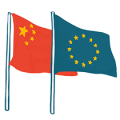

17+1 format + Diplomatic damage control + EU-US cooperation
Lithuania leaves 17+1 yet the format lives on
On May 21, Lithuanian Foreign Minister Gabrielius Landsbergis confirmed that “for practical purposes Lithuania is out” of the 17+1 China-Central and Eastern Europe (CEE) format. The Lithuanian government has been considering the withdrawal since the last 17+1 summit in February.
What you need to know
- Landsbergis called upon other member states to abandon the “dividing” 17+1 format in favor of a 27+1 approach. Lithuanian Ambassador to China, Diana Mickeviciene, argued that the decision was a reaction to underwhelming economic results of the framework. Last year China was 22nd on Lithuania’s list of export destinations. On the other hand, Chinese exports to Lithuania are rapidly increasing, and the trade imbalance is widening.
- Still, an assertive position on China is emerging. On May 20, the Lithuanian Seimas passed a non-binding resolution labeling China’s actions in Xinjiang as “genocide”. On May 25, the Seimas banned the usage of telecom equipment from “unreliable” manufacturers, from 2025 onwards which is being widely interpreted as Huawei.
- In a measured response Chinese MFA spokesperson Zhao Lijian stated that China-CEE cooperation remains based on “the principle of voluntary consultation”. But national outlets such as Global Times or China Daily featured a series of critical articles on Lithuania portraying the decision as a result of American influence exercised on a small country. Chinese think tank experts argued that the development can “reduce some negative assets” from CEE-China cooperation.
Quick take
Lithuania’s departure from the 17+1 forces Beijing to confront the shortcomings of the format and reconsider its offer to the CEE countries. Several of whom have begun to prioritize security and geopolitical considerations in relations with China over the past few years given their dissatisfaction with economic cooperation. Still with Lithuania out, it is unlikely for the format to be discontinued. Even Estonia which is similarly incentivized to prioritize security and geopolitics given Russia’s activity, has currently no clear plans to leave the framework. After all, the 27+1 approach to China is yet to materialize, and CEE countries may want to see how Beijing responds to the 17+1 crisis.
Read more
- Politico: Lithuania pulls out of China’s ’17+1′ bloc in Eastern Europe
- SCMP: Lithuania quit 17+1 because access to Chinese market did not improve, its envoy says
- LRT: Lithuania bans ‘unreliable’ technologies from its 5G network
- Global Times: Lithuania’s decision to quit China-CEEC 17+1 won’t change fundamentals of platform
China’s diplomatic damage control in Europe
Following recent setbacks in EU-China relations, Beijing launched a flurry of diplomatic engagements with European governments in an attempt to mitigate the tensions. Below the roundup.
What you need to know
- On May 26, President Xi Jinping exchanged a call with President Sanchez, who supported creating "the necessary climate of confidence" to ratify the Comprehensive Agreement on Investment (CAI).
- On May 27, Chinese commerce Minister Wang Wentao encouraged his French counterpart Franck Riester for France to lobby Europe for the ratification of CAI.
- Between May 26 and 27, Yang Jiechi, Party and Politburo member, visited Slovenia (who is currently starting its EU Presidency) and Croatia. In a meeting with Yang, President Borut Pahor stated that “the two countries share similar views and called for the strengthening of EU-China relations.” In Croatia, Prime Minister Andrej Plenković endorsed CEE-China cooperation echoing Beijing’s line.
- Between May 29 and 31, Foreign Ministers (FM) of Hungary, Ireland, Poland and Serbia travelled to Guiyang to meet their Chinese counterpart, Wang Yi. Hungary and Serbia each agreed to four and six loosely defined political action plans. The Polish FM stated that after necessary adjustments the 17+1 could be a constructive format for EU-China relations. According to the Chinese readouts, both the FMs of Poland and Ireland expressed support for CAI. Wang also used the exchanges to lobby that the EU and China remain comprehensive strategic partners as they share long-term, strategic interests.
Quick take
Beijing had all hands on deck to mitigate the recent tensions in EU-China relations and to lobby the European capitals that maintaining the comprehensive strategic partnership can be beneficial for them. China has been promoting this narrative also by attempting to leverage the EU’s aspiration for strategic autonomy, which we covered in detail here. The fate of CAI will be one of the key indicators of the level of partnership still possible. The agreement was put on hold by the European Parliament yet is reportedly still being endorsed by an increasing number of European capitals.
Read more
First EU-US high-level dialogue on China refines common position on China
On May 26, the EU and the United States held the first high-level EU-US dialogue on China bringing together deputies of their top diplomats – Secretary General Stefano Sannino and Deputy Secretary Wendy Sherman.
What you need to know
- The high-level dialogue on China was initially proposed by the EU High Representative Josep Borrell in June 2020 in his conversation with then Secretary of State Mike Pompeo. The framework was endorsed by the pair in late October, but only became operational under the Biden administration.
- According to the joint readout, the two sides confirmed that they see the relationship with China as multifaceted with “elements of cooperation, competition, and systemic rivalry” – using the European order, which puts cooperation first. Both sides reiterated points made in a recent G7 statement agreeing on shared concerns over China’s human rights misconduct, disinformation campaigns, actions in the South China Sea and shared support for Taiwan’s participation in the WHO. The dialogue is expected to be a platform for discussion on “resilience, human rights, security, multilateralism, and engagement” with the next high-level meeting scheduled for winter 2021/2022.
Quick take
While the EU and the US made no new statements on China, they stuck to the position agreed upon during the May G7 foreign ministers meeting. As shown also by the EU-Japan summit discussed below, the democratic countries appear to be developing their baseline agreement on China. Such multilateral framing helps to address some of the reservations that the EU has regarding working with the US on China, laying groundwork for the democratic cooperation on China that Beijing fears. The upcoming G7 summit (June 11-13) and the NATO summit (June 14) are both expected to further hone their common position.
Read more
Beijing criticizes the EU-Japan Summit
On May 27, the EU and Japan held an online summit bringing together Commissioner von der Leyen, President Michel and Prime Minister Yoshinide Suga. The joint statement released after the summit was met with criticism by China.
What you need to know
- During the summit, the EU and Japan agreed to further intensify their cooperation on connectivity and development initiatives and jointly support multilateral efforts such as COVAX, the WHO ran vaccine distribution initiative. The two also established a “Green Alliance” seeking synergy between their respective green transformation strategies. In the context of China, the joint statement reiterated points featured in the May G7 statement expressing concern over the situation in the East and South China Seas and in the Taiwan Strait. Both sides vowed to closely coordinate on matters in Hong Kong and Xinjiang as well as to align their wider relationships with China.
- The spokespersons of the Chinese MFA and the Mission of the PRC to the EU criticized the joint statement for going “beyond the norm of developing bilateral relations” by commenting on issues of China’s sovereign, internal affairs. But mindful of the efforts to decrease the tensions with the EU, the MFA aimed its criticism primarily at Japan, which it accused of “portraying China as a threat, ganging up with a few others to pursue geopolitical confrontation.”
Quick take
China feels confined by the increasing cooperation of democratic actors in formats such as G7 or the Quad on China related issues. There are rumors that the next G7 summit will launch an alternative to China’s Belt and Road Initiative called “Clean Green Initiative” – a step that might further increase Beijing’s anxiety. As a response, China recently focused its efforts on promoting its specific concept of “genuine multilateralism,” at the same time criticizing the “small cliques” of democratic countries, which it portrays as “self-serving” and “exclusive.” To learn more about China’s thinking on multilateralism read our latest EU-China Briefing.
Read more
Short takes
MEPs endorse plan on cooperation with Taiwan
On May 27, the Foreign Affairs Committee positively reviewed the draft of the first ever report on EU-Taiwan political relations and cooperation prepared by MEP Charlie Weimers.
- European Parliament: Draft report on European Parliament recommendation on EU-Taiwan political relations and cooperation
- Twitter: MEP Charlie Weimers presents the draft report
China overtakes Germany as top UK exporter
China became the lead import market for the UK overtaking Germany for the first time. The EU as a whole remains the UK’s key trading partner.
- The Guardian: China replaces Germany as UK’s biggest import market
- Quartz: UK-China relations in profiles – Meet the UK’s China watchers
Italian MPs adopts a resolution on Xinjiang
On May 26, the Italian Chamber of Deputies unanimously adopted a resolution condemning “China’s gross human rights violations” against Uighurs but omitted the term “genocide”.
- Twitter thread [IT]: Lia Quatrapelle, Italian MP, on the resolution
- Formiche [IT]: Uighurs, the Italian Parliament growls at Xi. But the genocide...
China considers extending grace period of Montenegro’s loan
On May 26, President Xi Jinping expressed China’s openness to discuss extending the grace period for Montenegro’s loan in a call with Montenegrin President Milo Đukanović.
- Euractiv: China willing to extend grace on loan for Montenegro motorway
- MERICS: EU rejects supporting Montenegro’s debt repayment to China
Hungary plans to locally produce Sinopharm vaccine
On May 31, Hungary unveiled plans to locally produce, Sinopharm’s vaccine, among others, in a plant worth EUR 157 million. The plant is to go operational in late 2022.

